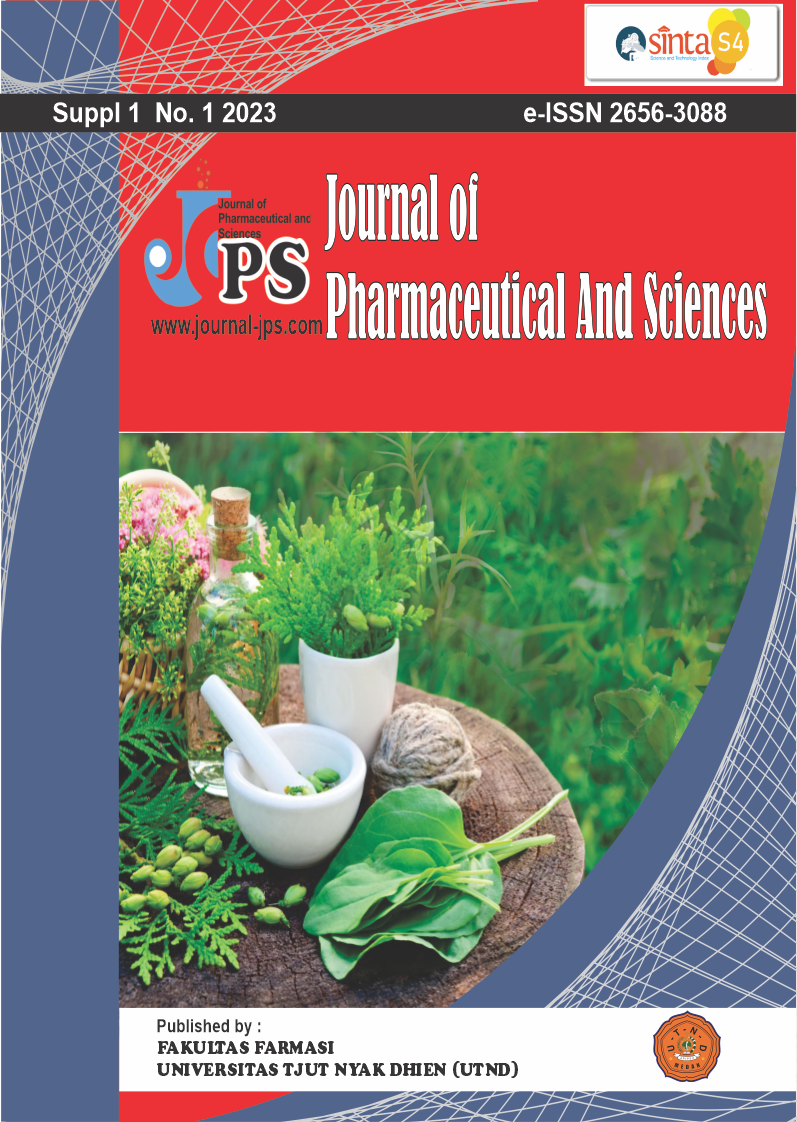Evaluation of the wound healing activity of ethanol extract fractions from kirinyuh leaves (Chromolaena odorata (L.) R.M. King & H. Rob) on incision wounds in white rats (Rattus norvegicus)
Main Article Content
Page: 91-98
Abstract
Kirinyuh (Chromolaena odorata (L.) R.M.King & H.Rob) is a plant from the Asteraceae family traditionally used for wound healing. This research aims to evaluate the wound healing activity of n-hexane, ethyl acetate, and n-butanol fractions derived from kirinyuh ethanol extract (Chromolaena odorata (L.) R.M.King & H.Rob). The study employed a post-test control group design in vivo using white rats (Rattus norvegicus) induced with a 3 cm long and 2 mm deep incision wound. The test formulations were applied twice a day in the morning and evening for 10 days at a dosage of 0.5 g per treatment. Wound healing effects were assessed based on the percentage of wound healing and histopathology of rat skin. The results indicated that all test fractions demonstrated wound-healing effects. The ethyl acetate fraction exhibited the most significant effect on incision wound healing compared to the positive control and the other two fractions, achieving a 75% wound healing percentage. Additionally, histopathological observations of rat skin revealed improved collagen content and epithelial cell thickness in the ethyl acetate fraction. Therefore, the ethyl acetate fraction holds the potential for development as a topical formulation in wound healing.
Downloads
Article Details

This work is licensed under a Creative Commons Attribution-NonCommercial-ShareAlike 4.0 International License.
References
Barua, R. N., Sharma, R. P., Thyagarajan, G., & Hertz, W. (1978). Flavonoids of Chromolaena odorata. Phytochemistry, 17(10), 1807–1808. https://doi.org/10.1016/S0031-9422(00)88710-5
Carvalho, M. T. B., Araújo-Filho, H. G., Barreto, A. S., Quintans-Júnior, L. J., Quintans, J. S. S., & Barreto, R. S. S. (2021). Wound healing properties of flavonoids: A systematic review highlighting the mechanisms of action. Phytomedicine : International Journal of Phytotherapy and Phytopharmacology, 90. https://doi.org/10.1016/J.PHYMED.2021.153636
Dorsett-Martin, W. A. (2004). Rat models of skin wound healing: a review. Wound Repair and Regeneration : Official Publication of the Wound Healing Society [and] the European Tissue Repair Society, 12(6), 591–599. https://doi.org/10.1111/J.1067-1927.2004.12601.X
Efendi, M. R. (2019). Skrining Aktivitas Antibakteri Fraksi Kelopak Bunga Mussaenda frondosa L. Journal of Pharmaceutical And Sciences, 2(1), 38–44. https://doi.org/10.36490/JOURNAL-JPS.COM.V2I1.18
Efendi, M. R., Gusti, D. R., Syahrial, A. D., & Rusdi, M. S. (2023). Evaluation of Coffee Mistletoe Leaf Ethanol Extract on Burn Healing Activity on White Male Rat. Journal of Pharmaceutical and Sciences, 6(3), 1059–1067. https://doi.org/10.36490/JOURNAL-JPS.COM.V6I3.72
Kementerian Kesehatan RI. (2017). Farmakope Herbal Indonesia (2nd ed.). Jakarta: Direktorat Jenderal Kefarmasian dan Alat Kesehatan. Retrieved from https://farmalkes.kemkes.go.id/2020/08/farmakope-herbal-indonesia-edisi-ii-tahun-2017-3/
Kurniawaty, E., Marga, M. P., Kurniati, I., A.Audah, K., & Andriani, S. (2022). The Effect of Mangrove Leaf Extract (Bruguiera Gymnorrhiza) on the Histopathology of the Skin of White Rats (Rattus Norvegicus) Which Has Been Subjected. Current Science, 2(2), 94–101. Retrieved from https://currentscience.info/index.php/cs/article/view/59
Munro, R., & Munro, H. M. C. (2008). Wounds and Injuries. Animal Abuse and Unlawful Killing, 30–47. https://doi.org/10.1016/B978-0-7020-2878-6.50015-5
Pandith, H., Zhang, X., Liggett, J., Min, K.-W., Gritsanapan, W., & Baek, S. J. (2013). Hemostatic and Wound Healing Properties of Chromolaena odorata Leaf Extract. ISRN Dermatology, 2013, 1–8. https://doi.org/10.1155/2013/168269
Phan, T. T., Wang, L., See, P., Grayer, R. J., Chan, S. Y., & Lee, S. T. (2001). Phenolic compounds of Chromolaena odorata protect cultured skin cells from oxidative damage: implication for cutaneous wound healing. Biological & Pharmaceutical Bulletin, 24(12), 1373–1379. https://doi.org/10.1248/BPB.24.1373
Sanik, F., Rahman, H., Rahman, A. O., Samudra, A. G., Floris, C. de, & Muhaimin, M. (2022). Incision wound healing test ethanolic extract gel from Ekor Naga (Rhaphidophora pinnata (L.f) Schott) leaves in white male rats. Pharmaciana, 12(2), 173–180. https://doi.org/10.12928/PHARMACIANA.V12I2.22825
Sirinthipaporn, A., & Jiraungkoorskul, W. (2017). Wound Healing Property Review of Siam Weed, Chromolaena odorata. Pharmacognosy Reviews, 11(21), 35–38. https://doi.org/10.4103/PHREV.PHREV_53_16
Wilkinson, H. N., & Hardman, M. J. (2020). Wound healing: cellular mechanisms and pathological outcomes. Open Biology, 10(9), 341–370. https://doi.org/10.1098/RSOB.200223





